When you are roaring up Sixth Avenue in a cab sometime, divert your attention from your cell phone and take a look at the edge of some very old houses at King Street. They are part of the Charlton-King-Vandam Historic District (between 6th Avenue and Varick Street) and comprise some 72 Federal- and Greek Revival-style houses, many of them built as early as the 1820s. They stand on land known from the late 1700s as Richmond Hill.
The land had passed down from the Dutch era, the late 1600s, from a freed slave called Symon Congo to Trinity Church to British major Abraham Mortimer (who built the mansion that gave Richmond Hill its name). After the revolution, Richmond Hill became the official residence of the Vice-President for just one year when the Capitol was located in NYC. In 1794, Richmond Hill became home to Senator Aaron Burr, later Vice-President and Alexander Hamilton’s killer in their 1804 duel. In 1817, Burr sold the property to fur magnate John Jacob Astor, but the mansion’s days were numbered when Charlton and King Streets were cut through. It was placed on logs and rolled 45 feet away from the street. This bought it some time, and it survived as a tavern, a country resort, and a theater; it was razed in 1849. Meanwhile, Astor saw a profitable real-estate investment at Richmond Hill and built dozens of row houses on Charlton, King, and Vandam Streets, and luckily, most have survived to the present.
Oddly the district, to me, should be called the Vandam-Charlton-King district, matching the running order south to north, but the city chose to follow the alphabet.
Vandam Street
This is always spelled on NYC maps as Vandam, not the Dutch Van Dam, and both Brooklyn and Queens spell their Van Dam Streets with two words. I don’t know if SoHoites say VAN’dam, or the equal emphasis of VAN DAM. The street, according to Henry Moscow’s Street Book, was named for a prosperous merchant, Rip Van Dam, who governed NYC from 1731-1732 despite not knowing a word of English. New York was between British governors at the time. In Sanna Feirstein’s Naming New York, she insists it was named for a liquor dealer, Anthony Van Dam. I don’t know when the space between the Van and Dam was eliminated.

25, 27 and 29 Vandam Street (from right to left) have maintained close to their original appearance since they were built in the 1820s, with pitched roofs, dormers and delicate ironwork.

Ditto, #21, 23, and showing #25 again, all more or less perfectly preserved. Some relics are to be found if you look closely. Name that car in front of #21!

#21 has a large circular sign affixed beside the doorway, apparently wood cast iron, with “21 Renato” chiseled into it. This was a mystery to me until I found a postcard:

Renato’s was a mid-20th Century Italian restaurant operated by Renato Trebbi and established in 1923, and for all my searching, my research is silent on anything further. I wonder if the sign dates back to the restaurant, and if the current owners have kept it around for purely esthetic considerations.
In Comments: the restaurant closed in 1976.

I’m unsure if all the houses in the district one had doors like this, with freestanding Ionic columns guarding the entrance, and a stained glass transom window. In any case the owners of #25 have excellently preserved theirs.
#15 Vandam would be another in the handsome row of 1820s Federal style houses if not for the fact that Tammany Democrats founded the Huron Club here in the late 19th Century as a clubhouse. Prominent clubmen included Dan Finn (whose son, a WWI hero, is honored by Finn Square) and Jimmy Walker, NYC mayor 1925-1932. A theater was founded in the 1920s at #15 Huron and has been known by various names including the Village South and the SoHo Playhouse. Works by playwrights Terrance McNally, Sam Shepard and LeRoi Jones have been produced here. A basement nightclub is called, naturally, the Huron Club.
#13 is another in the Vandam row, but it is adorned with a sea shell and small plaque in the front identifying it as the former residence of artist Marguerite Stix (1908-1967). She founded the Rare Shell Gallery here in 1964.
To Marguerite Stix art and life were inseparable. As a gifted child, a prize-winning student, a concentration camp prisoner, a penniless refugee, a designer of accessories for the haute couture, a factory worker, a recognized sculptor and painter, a creator of widely sought-after jewelry and of fantastic ephemera, she never departed from her deeply felt celebration of life and its meaning. Human sensibility, the wonders of nature, exuberance or despair, humor or play, vulnerability or bravado, infancy or old age, the simple joys of home or the elegance of the privileged world – all called into play her extraordinary talents…
… Although Stix is best known for her work with seashells, the foremost element in her work, whether pictorial or sculptural, is the poignancy of the vulnerable creature, animal or human. The tremulous newborn horses, the troubled women, the haggard and touching portraits of Lincoln, the ebullient children and fleeting groups of the young – these evoke in the observer the tenderness and compassion implied by the artist’s own involvement. Her technique, though formidable, and her uses of style and medium; however experimental, never override the flash of mood or sensation. Even in the landscapes, still lives and interiors, this immediacy is present. Her work will speak to anyone who values life and beauty. Stair Galleries

#9 Vandam Street retains a street level door with an oval window above it, a passageway to a former back house or a stable. This is the first address on Vandam, and you may ask, what happened to #1 through #8? The answer is simple. In 1928 6th Avenue was extended south from Minetta Lane to the intersection of Church and Franklin Streets, a downtown realm where no numbered avenues had previously penetrated, along the new cut for the IND 6th and 8th avenue Lines, which were under construction. In a pre-Landmarks Preservation Commission era, buildings were torn down for Progress, no matter how historic they may have been.

Even though it’ll be completely facing 6th Avenue and not on Vandam at all, developers have decided to revive the #1 Vandam designation for a no-doubt overpriced luxury building rising at the intersection.
On this stretch of 6th Avenue between Canal and West 4th Street, there are some surviving medallions honoring the Organization of American States. 6th Avenue was renamed “Avenue of the Americas” by Fiorello LaGuardia in 1945 and the medallions appeared about 1960. Most were taken out between 1990 and 1992 when lengthy stretches of the avenue were repaved and given new lampposts, and the medallions that were taken down were never reinstalled. Most are showing the effects of 5 decades of rust and wear and tear.
“Avenue of the Americas” is a mouthful, and while it appears on letterheads and street signs it never caught on with the public. In the 1990s, the Department of Transportation gave in and installed “6th Avenue” signs.
Back in 2002, I made a survey of the remaining medallions.
Charlton Street
Along with Prince Street, which it “becomes” once it crosses 6th Avenue, Charlton Street is a remnant of British rule in NYC; it is named for British physician Dr. John Charlton, who arrived with the British army in 1762, but later sided with US patriots. He treated Chief Justice John Jay.

#9 Charlton Street is the first house on the street, for similar reasons to Vandam Street. When 6th Avenue was built in 1928, #1 Charlton was torn down: it was a former residence of Clement Clarke Moore, of “A Visit From St. Nicholas” fame; he later owned a lot of territory in Chelsea.

#15 (right) and #17 Charlton, a former residence of acting couple Matthew Broderick and Sarah J. Parker.
Charlton Street, on its north side, retains what is probably the longest row of Federal and early Greek Revival houses in the City. Such continuity of period and such excellent state of preservation is not known to exist anywhere else, even including Greenwich Village and Brooklyn Heights, To walk these streets is as delightful and unexpected a step into the past as to walk up Cheyne Row in London. LPC Designation Report

#19 and #21 Charlton Street

#23 and #25 Charlton; as we have seen on Vandam, #23 once let visitors into aback house or stable. Poet Edna St. Vincent Millay once resided at #25.
#37 and #39, built in 1827, retain iconic Ionic columns at the front entrances, leaded glass in the transom windows and retain their original ironwork. #37 was another Tammany club at one time; Peter, Paul & Mary singer Mary Travers lived at #39 while growing up, and actress Linda Hunt (“The Year of Living Dangerously”) lived at #39 in the 1980s.
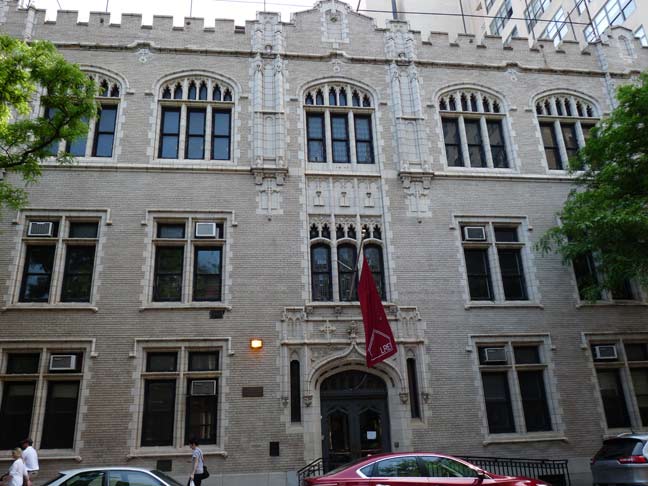
#40 Charlton, the Elisabeth Irwin High School, is a 1941 addition to Greenwich Village’s “Little Red Schoolhouse” on 6th Avenue and Bleecker Street.
In 1921, Elisabeth Irwin founded the experimental school at P.S. 16 on East 16th Street in a red-bricked building annex; by 1932, it had moved to another red brick building at 196 Bleecker. It was among the first schools to try field trips, psychological testing, and may other ideas later adopted by mainstream education. The Schoolhouse is now located at 272 Sixth Avenue at Bleecker. The “LREI” on the banners, etc. stands for Little Red and Elisabeth Irwin.

In 2008, LREI acquired adjoining #42 Charlton, one of the 1820s townhouses of the district and one of four originals on the south side of Charlton Street.
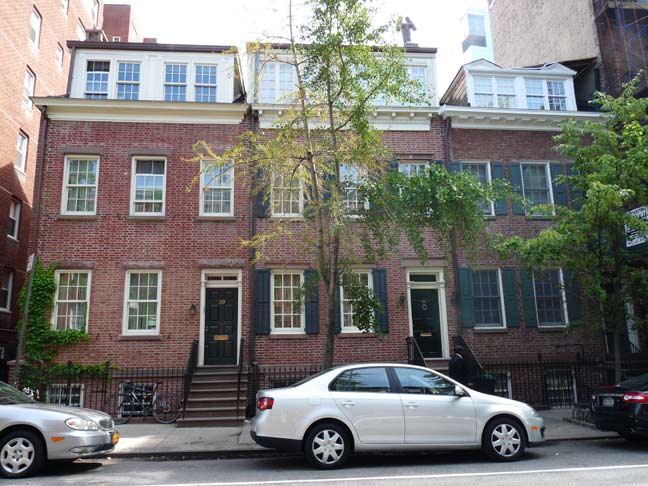
#20-24 Charlton, on the south side of Charlton. Singer/actor/activist Paul Robeson was a resident of #24 in the 1930s and 1940s.
King Street
A bona fide Founding Father, Rufus King (1755-1827) who was born in what is now Maine but was then part of Massachusetts, was a youthful representative at the Continental Congress from 1784-1786, a US Senator from New York in 1789, a Minister (Ambassador) to Great Britain from 1796-1803 (where he impressed the still-hostile Brits after the close of the Revolutionary War), a US Senator again from 1813 to 1825, and ran unsuccessfully for President as a Federalist against James Monroe in 1816. In 1805, King purchased and later expanded an existing mansion in the wilds of Jamaica, Long Island, now the King Manor Museum. King, an ardent opponent of slavery, argued: “I have yet to learn that one man can make a slave of another and if one man cannot do so, no number of individuals have any better right to do it.”
Another pair of OAS medallions, for Cuba and Uruguay, at 6th Avenue and King Street.

King Street is the only one of the district’s streets to extend east of 6th Avenue, a half block to Macdougal Street. NYC King of Lampposts Bob Mulero sent me this picture of a castiron lamppost base at King and Macdougal, and it must have survived into the 1990s since I do remember it.

On King Street, Numbers 15 and 17, at 6th Avenue, most clearly retain their original Federal flavor. Although their doors and lintels have been altered, they retain their original pitched roofs, dormers and cornices. The doorways are in their original state, as are their shallow stoops.

#20 King is another well-preserved Greek Revival house of the 1820s.

#19 (right) and #21 King Street. #19 was recently (late 2013) on the market for almost $8M. There are no fewer than 6 woodburning fireplaces within, according to Curbed.

#40-44 King Street. “Their brownstone doorways, strict and linear, their window lintels, their roof cornices with frames, their ironwork with Grecian motifs – their stair railings terminating on handsome columns of brownstone – are all there.” – LPC Report

#45-49 King Street. Simple but effective Federal-style buildings from the 1820s.

#29 King Street, constructed in 1886 (the date is on the parapet) is more recent and much larger than the other houses on the north side of the street. It was built as Public School #8; only eight years after opening, the building was considered inadequate and unsanitary, but PS 8 soldiered on until in 1958 it became the Livingston School for Girls, a last resort for girls thought to be unreachable by other educational methods and disciplines. Finally it was converted to luxury apartments in 1981. Daytonian in Manhattan, as usual, has the whole story.

#41 (right) and #43 King Street. #43 has been altered and now boasts unusual window treatments.

These early multi-unit apartment buildings on the south side of King Street were built in 1901.

An original IND enamel sign was uncovered when a newsstand was removed from the entrance to the West 4th Street station on 6th Avenue. How long will the MTA tolerate such a nonstandard sign? Modern subway riders don’t think in terms of the 6th Avenue and 8th Avenue lines anymore, but of the lines serving this station, the trains with the orange ID bullets, the B, D, F and M, run up 6th Avenue while the ones with the blue bullets, A, C, E, go up Greenwich Avenue and 8th Avenue.
Some information culled from Jim Naureckas’ New York Songlines.
6/29/14


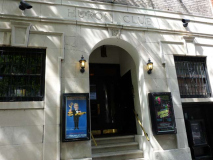
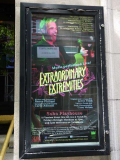
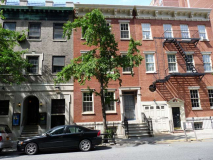
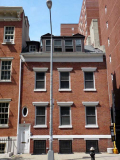
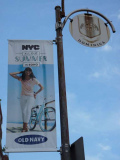
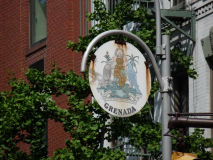
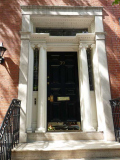
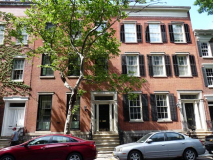
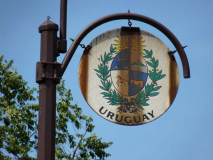

16 comments
If this wasn’t a historic district, much of this great architecture probably would have been torn down and replaced by modern run of the mill buildings by developers trying to make a profit.
I used to work right by there, and #27 Vandam has been recently renovated/restored.
Also, The Boys in the Band premiered at the SoHo Playhouse.
Re: Name that car
Chevrolet Caprice, 1980-90 (you’d think that in such an exclusive neighborhood the automotive relics would be Jaguars, or Packards, etc., instead of this forlorn beater).
Hey #9 Vandam was Leontyne Price’s townhouse (pics of interior at time of listing at link): http://operachic.typepad.com/opera_chic/2012/10/leontyne-price-is-on-the-move.html
Listed by her in 2012 for $5 Million, later sold in 2013 (after a reduction or two in listing price) for $4.2M…
http://therealdeal.com/blog/2013/08/29/trailblazing-opera-singer-finds-buyer-for-fading-beauty-townhouse/
Beautiful historic district of Federal and Greek Revival style rowhouses. I wonder how some of these houses have been permitted to have air conditioning vents punctuating their front brick facades, unless these were grandfathered in before the homes were landmarked.
Love the article and pics Kevin!!! Have not been down this way in quite a while. Love the columns and windows.
Is there a way to fix the article so the right hand side isn’t cut off (I can pretty much make it out, I think).
Thank you
What are you viewing the page on? I’m using an old WordPress template that doesn’t play well with mobiles, it’s a not easily solved problem — I’d have to acquire a modern template and redo the whole site. My views are dropping off, so it’ll have to be done eventually.
My iPhone offers “READER” which handles this web page design well.
http://nypost.com/2014/07/04/secret-vegetable-garden-grows-along-the-fdr-drive/
Salad days are upon you
Renato’s was a restaurant from 1923 to 1976. The sign is cast iron (not wood as reported).
one of the last gasps of the Livingston School for Girls
was when a group of students pushed a cop off the platform
at the nearby IRT station.
Thank you for writing about Renato’s restaurant, and sharing the post card. The scene in the post card is the very pleasant terrace that was used in warm weather. The dining room was on the parlor floor of the building, and entry to the terrace was from the home’s original dining room, which was a nicely proportioned square (or almost square) room, with tables also in the long, narrow room that was the home’s original parlor. My recollection is that guests had to walk down a few stairs to reach the terrace.
As I recall, entry to the restaurant was on the ground floor, and then guests climbed an interior stair case to the dining room.
In the time that I knew Renato’s (1959 – early 70s) the maitre d’ was an immensely warm and charming man named Joseph (pronounced dzho SEFF), who greeted guests in a way that made them feel that they were exactly the folks he wanted to see. When he became ill and had to retire in the early 70’s the clientele fell off: a Mr. Dante, who succeeded Joseph, was perfectly nice but had neither Joseph’s warmth or flair. The food was just as good, but the special quality of welcome was lost.
I remember birthday cakes being presented with a flourish–with sparklers on them instead of candles. But perhaps the best illustration of what Renato’s was like is my memory of my first visit when I was almost six years old. My mother was in the hospital on the arrival of my younger brother, and my father took my almost 9 year old brother and me to Renato’s for dinner. Our father told us we must be on our best behavior, and (as a precaution) we were seated at a table at the end of the long former parlor so as not to disturb the other guests, who were gathered in what had been the home’s original dining room. Joseph came to take our order, and–innocently assuming that Italian food consisted mostly of spaghetti–this is what my brother and I asked for. Joseph said kindly that they didn’t have round spaghetti, but they DID have flat spaghetti (fettuccine) that tasted just the same. With our best “company” manners we mortified our father by politely insisting that flat spaghetti couldn’t possibly taste as good as round spaghetti. Joseph looked thoughtful and said OK. And after a rather long wait we were served round spaghetti with a delicious tomato sauce: Joseph had solved the problem by sending a waiter out to a local deli to buy round spaghetti. You may be sure that our father never let us live that one down!
Such a great story! Even the *tiny* customer was always right – apparently. And shame on you (*rubs one finger against the other pointed at you* as my grandmother did – as if scraping a carrot) !!!
Would the apartment buildings (built in 1901) shown on the south side of King Street include #27? Just learned that my grandparents lived there in 1925. Thanks for posting these….it is a wonderful history lesson.
Wonderful survey! Our family lived at 34 King Street, then owned by my grandmother, where I lived and was brought up (1951-1963). I attended kindergarten and first grade at P.S. 8 directly across the street at 29 King, now a large apartment house. A family cousin, Mary Pogee, lived on the corner at 15 King St. Next door, at 17 (see photo above), lived noted Pulitzer Prize winning writer, James Agee (1909-1955). I was childhood friends with his son, John Agee, and was a regular visitor to the house where James Agee’s third wife, Mia, also lived. I still remember the adventures I had with John, the distinct aroma of the house, the open-door hospitality, and the accent (I believe German) with which Mia spoke. I wonder where John is today!
A few doors down on the same side of the block, it was either 19 or 21, was the residence of actor Tim Robbins. I had come face-to-face with him once or twice during the course of childhood street play; and I remember seeing Tim and his brother out playing together very early (like 7:00 AM) every Saturday morning.
Some time later, it was the 1980s or 1990s, actress Yancy Butler (starring in the 1992 TV series, Mann and Machine) briefly lived at 32 King St.
Further down on the North side of the street lived the Tarigo sisters, one of whom, Gloria, continues to operate a pastry business, Let Them Eat Cake, and I believe still lives there. She can be found on Facebook.
After Hurricane Sandy, the building in which I was raised, 34 King, was apparently badly damaged. Since that time it has been vacant and has undergone extensive reconstruction. The fact that the premises has remained vacant and under construction these past six years suggests the project has been stalled or met with ongoing obstacles.